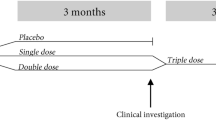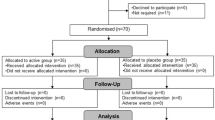Abstract
Objective:
To investigate the effect of probiotic capsules on plasma lipids.
Design:
A randomized, single-blinded, placebo-controlled, parallel-arm trial.
Subjects:
Fifty-five normocholesterolemic subjects ages 18–36 (33 premenopausal women and 22 men).
Intervention:
Each subject consumed either three probiotic capsules each containing a total of 109 colony-forming units Lactobacillus acidophilus and Bifidobacterium longum and 10–15 mg fructo-oligosaccharide or three placebo capsules daily for 2 months (men) or two menstrual cycles (women). Plasma lipids were measured before and following the intervention (during the early follicular phase for women).
Results:
Plasma concentrations of total cholesterol, high-density lipoprotein cholesterol, low-density lipoprotein cholesterol and triglyceride were not altered by consumption of probiotic or placebo capsules and were not different between treatment groups following the intervention.
Conclusions:
These results do not support a beneficial effect of Lactobacillus acidophilus strain DDS-1 and Bifidobacterium longum strain UABL-14 on plasma lipids in normocholesterolemic young women and men.
Sponsorship:
Supported by the Minnesota Agricultural Experiment Station and UAS Laboratories.
This is a preview of subscription content, access via your institution
Access options
Subscribe to this journal
Receive 12 print issues and online access
$259.00 per year
only $21.58 per issue
Buy this article
- Purchase on Springer Link
- Instant access to full article PDF
Prices may be subject to local taxes which are calculated during checkout
Similar content being viewed by others
References
Agerback M, Gerdes L, Richelsen B (1995). Hypocholesterolemic effect of a new fermented milk product in healthy middle-aged men. Eur J Clin Nutr 49, 346–352.
Bertolami MC, Faludi AA, Batlouni M (1999). Evaluation of the effects of a new fermented milk product (Gaio) on primary hypercholesterolemia. Eur J Clin Nutr 53, 97–101.
Block G, Hartmann AM, Dresser CM, Carrol MD, Gannon J, Gardner L (1986). A data-based approach to diet questionnaire design and testing. Am J Epidemiol 124, 453–469.
Brashears MM, Gilliland SE, Buck LM (1998). Bile salt deconjugation and cholesterol removal from media by Lactobacillus casei. Journal of Dairy Science 81, 2103–2110.
Carr T, Andresen C, Rudell L (1993). Enzymatic determination of triglyceride, free cholesterol, and total cholesterol in tissue lipid extracts. Clin Biochem 26, 39–42.
Castelli W (1986). Incidence of coronary heart disease and lipoprotein cholesterol levels: The Framingham study. JAMA 256, 2835–2838.
Charteris W (1998). Development and application of an in vitro methodology to determine the transit tolerance of potentially probiotic Lactobacillus and Bifidobacterium species in the upper human gasterointestinal tract. J Appl Microbiol 84, 759–768.
Dambekodi PC, Gilliland SE (1998). Incorporation of cholesterol into the cellular membrane of Bifidobacterium longum. J Dairy Sci 81, 1818–1824.
de Roos NM, Schouten G, Katan MB (1999). Yoghurt enriched with Lactobacillus acidophilus does not lower blood lipids in healthy men and women with normal to borderline high serum cholesterol levels. Eur J Clin Nutr 53, 277–280.
Expert Panel of Detection, Evaluation, and Treatment of High Blood Cholesterol (2001). Executive Summary of the Third Report of the National Cholesterol Education Program (NCEP) Expert Panel on Detection, Evaluation, and Treatment of High Blood Cholesterol in Adults (ATP III). JAMA 285, 2486–2497.
Friedewald W, Levy R, Fredrickson D (1972). Estimation of the concentration of low-density lipoprotein cholesterol in plasma, without use of the preparative ultracentrifuge. Clin Chem 18, 499–502.
Greany KA, Nettleton JA, Wangen KE, Thomas W, Kurzer MS (2004). Probiotic consumption does not enhance the cholesterol-lowering effect of soy in postmenopausal women. J Nutr 134, 3277–3283.
Grundy SM, Cleeman JI, Merz NB, Brewer B, Clark LT, Hunninghake DB et al. (2004). Implications of Recent Clinical Trials for the National Cholesterol Education Program Adult Treatment Panel III Guidelines. Circulation 110, 227–239.
Guarner F, Schaafsma G (1998). Probiotics. Int J Food Microbiol 39, 237–238.
Hlivak P, Odraska J, Ferencik M, Ebringer L, Jahnova E, Mikes Z (2005). One-year application of probiotic strain Enterococcus faecium M-74 decreases serum cholesterol levels. Bratisl Lek Listy 106, 67–72.
Kaur IP, Chopra K, Saini A (2002). Probiotics: potential pharmaceutical applications. Eur J Pharm Sci 15, 1–9.
Klag MJ, Ford DE, Mead LA, Jiang H, Whelton PK, Liang K et al. (1993). Serum cholesterol in young men and subsequent cardiovascular disease. New Engl J Med 328, 313–318.
Klaver FA, van der Meer R (1993). The assumed assimilation of cholesterol by Lactobacilli and Bifidobacterium bifidum is due to their bile salt-deconjugating activity. Appl Environ Microbiol 59, 1120–1124.
Lewis SJ, Burmeister S (2005). A double-blind placebo-controlled study of the effects of Lactobacillus acidophilus on plasma lipids. Eur J Clin Nutr 59, 776–780.
Lin SY, Ayres JW, Winkler Jr W, Sandine WE (1989). Lactobacillus effects on cholesterol: in vitro and in vivo results. J Dairy Sci 72, 2885–2899.
Liong MT, Shah NP (2005). Acid and bile tolerance and cholesterol removal ability of lactobacilli strains. J Dairy Sci 88, 55–66.
Lipid Research Clinics Program (1984). The Lipid Research Clinics coronary primary prevention trial results. I. Reduction in incidence of coronary heart disease. II. The relationship of reduction in incidence of coronary heart disease to cholesterol lowering. JAMA 251, 351–374.
Madley R (2001). Probiotics, prebiotics, and synbiotics: harnessing enormous potential. Nutraceuticals World 9, 50–58.
Mann GV (1977). A factor in yogurt which lowers cholesterolemia in man. Atherosclerosis 26, 335–340.
McVeigh BL, Dillingham BL, Lampe JW, Duncan AM (2006). Effect of soy protein varying in isoflavone content on serum lipids in healthy young men. Am J Clin Nutr 83, 244–251.
Merz-Demlow BE, Duncan AM, Wangen KE, Xu X, Carr TP, Phipps WR et al. (2000). Soy isoflavones improve plasma lipids in normocholesterolemic, premenopausal women. Am J Clin Nutr 71, 1462–1469.
Mital BK, Garg SK (1995). Anticarcinogenic, hypocholesterolemic, and antagonistic activities of Lactobacillus acidophilus. Crit Rev Microbiol 21, 175–214.
Mohan JC, Arora R, Khalilullah M (1990). Short term hypolipidemic effects of oral Lactobacillus sporogenes therapy in patients with primary dyslipidemias. Indian Heart J 42, 361–364.
Noh DO, Kim SH, Gilliland SE (1997). Incorporation of cholesterol into the cellular membrane of Lactobacillus acidophilus ATCC 43121. J Dairy Sci 80, 3107–3113.
Richelsen B, Kristensen K, Pedersen S (1996). Long-term effect of a new fermented milk product on the level of plasma lipoproteins - a placebo-controlled and double blind study. Eur J Clin Nutr 50, 811–815.
Sanders ME (1998). Development of consumer probiotics for the US market. Brit J Nutr 80, S213–S218.
Scandinavian Simvastatin Study Group (1994). Randomized trial of cholesterol lowering in 4444 patients with coronary heart disease: The Scandinavian Simvastatin Survival Study (4S). Lancet 344, 1383–1389.
Schaafsma G, Meuling WJ, van Dokkum W, Bouley C (1998). Effects of a milk product, fermented by Lactobacillus acidophilus and with fructooligosaccharides added, on blood lipids in male volunteers. Eur J Clin Nutr 52, 436–440.
St-Onge MP, Farnworth E, Jones PJH (2000). Consumption of fermented and nonfermented dairy products: effects on cholesterol concentrations and metabolism. Am J Clin Nutr 71, 674–681.
Strandberg TE, Strandberg A, Rantanen K, Salomaa VV, Pitkala K, Miettinen TA (2004). Low cholesterol, mortality, and quality of life in old age during a 39-year follow-up. J Am Coll Cardiol 44, 1002–1008.
Tanaka H, Doesburg K, Iwasaki T, Mierau I (1999). Screening of lactic acid bacteria for bile salt hydrolase activity. J Dairy Sci 82, 2530–2535.
Wong WW, Smith EO, Stuff JE, Hachey DL, Heird WC, Pownell HJ (1998). Cholesterol-lowering effect of soy protein in normocholesterolemic and hypercholesterolemic men. Am J Clin Nutr 68, 1385S–1389S.
Xiao JZ, Kondo S, Takahashi N, Miyaji K, Oshida K, Hiramatsu A et al. (2003). Effects of milk products fermented by Bifidobacterium longum on blood lipids in rats and healthy adult male volunteers. J Dairy Sci 86, 2452–2461.
Acknowledgements
This research was supported by the General Clinical Research Center Grant MO1-RR00400 from the National Center for Research Resources and the Minnesota Agricultural Experiment Station. We thank the study participants for their time and dedication, as well as the staff at the General Clinical Research Center, University of Minnesota. The probiotic capsules were donated by UAS Laboratories, Minnetonka, Minnesota.
Author information
Authors and Affiliations
Corresponding author
Additional information
Guarantor: MS Kurzer.
Contributors: KAG was the primary author, assisted with subject recruiting and study coordination, and performed the lipid analysis; MJLB, JMH-R and MHM assisted with subject recruiting and study coordination, KEW assisted with study design; WRP assisted with study design and provided medical consulting; JF assisted with study design and provided microbiological consulting; WT assisted with study design and statistical analysis; MSK was the principal investigator and supervised all aspects of the study. All authors contributed to the data interpretation and manuscript preparation.
Rights and permissions
About this article
Cite this article
Greany, K., Bonorden, M., Hamilton-Reeves, J. et al. Probiotic capsules do not lower plasma lipids in young women and men. Eur J Clin Nutr 62, 232–237 (2008). https://doi.org/10.1038/sj.ejcn.1602719
Received:
Revised:
Accepted:
Published:
Issue Date:
DOI: https://doi.org/10.1038/sj.ejcn.1602719
Keywords
This article is cited by
-
Efficacy of Probiotic Milk Formula on Blood Lipid and Intestinal Function in Mild Hypercholesterolemic Volunteers: A Placebo-control, Randomized Clinical Trial
Probiotics and Antimicrobial Proteins (2021)
-
The effect of synbiotics supplementation on anthropometric indicators and lipid profiles in women with polycystic ovary syndrome: a randomized controlled trial
Lipids in Health and Disease (2020)
-
Probiotic characteristics of Lactobacillus plantarum E680 and its effect on Hypercholesterolemic mice
BMC Microbiology (2020)
-
A review of probiotic supplementation in healthy adults: helpful or hype?
European Journal of Clinical Nutrition (2019)
-
The use of probiotics for improving lipid profiles in dyslipidemic individuals: an overview protocol
Systematic Reviews (2018)



